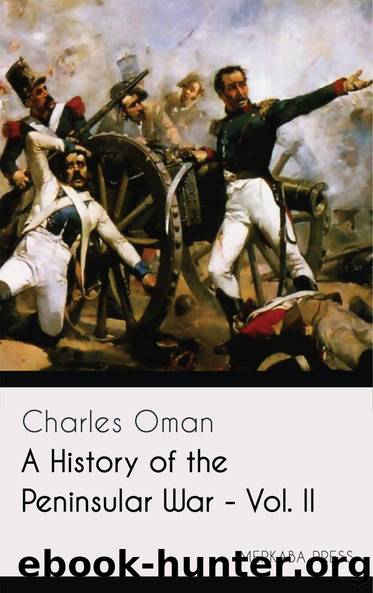A History of the Peninsular War, Vol. 5, Oct. 1811-Aug. 31, 1812 by Charles Oman

Author:Charles Oman [Oman, Charles]
Language: eng
Format: epub
Tags: History, Nonfiction, Military
ISBN: 6610000024742
Publisher: PublishDrive
Published: 2017-08-04T04:00:00+00:00
Meanwhile, if the financial outlook was gloomy, the actual military situation was more promising than it had ever been before. Well aware, from intercepted dispatches, of the quarrels of his adversaries, and perfectly informed as to their numbers and their cantonments, Wellington considered with justice that he had such a game in his hands as he had never before had set before him. On June 13th he crossed the Agueda with his army in three parallel columns. The left was under charge of Picton, and consisted of the 3rd Division, Packâs and Bradfordâs Portuguese, and Le Marchantâs brigade of heavy dragoons. The centre, which Beresford conducted, was composed of the Light, 4th, and 5th Divisions. It was preceded by Altenâs German hussars, and accompanied by Bockâs dragoons. The right column, under Graham, had the 1st, 6th, and 7th Divisions, with a regiment of Ansonâs horse for purposes of exploration. It is to be noted that both Picton and Graham were destined to remain only a few weeks with the army: the former had taken the field ere his Badajoz wound was properly healed: it broke open again, he fell into a high fever, and had to be sent to the rear. Wellingtonâs brother-in-law, Pakenham, took over charge of the 3rd Division on June 28th. Graham had been suffering for some months from an affection of the eyes, which the physicians told him might at any time grow worse and threaten his sight. He persisted on staying with the army till the last possible moment, but became more blind each day, and was compelled to throw up his command on July 6th and to return to England for skilled medical advice. Thus, during the greater part of the Salamanca campaign, Wellington was working without his best-trusted lieutenantsâCraufurd was dead, both Picton and Graham invalided. In consequence of Grahamâs departure a very difficult point was raised. If some illness or wound should disable the Commander-in-Chief, to whom would the charge of operations fall[415]? Wellington considered that Beresford was entitled to expect the succession, and deprecated the sending out of some senior officer from England with a commission to act as second in command. He observed that no one coming fresh from home would have a real grasp of the conditions of the war: that he would probably start with a priori views, and have to unlearn them in a time of imminent danger. Moreover, a second-in-command was, when his superior was in good health, either an unnecessary person or else a tiresome one, if he presumed on his position to offer advice or remonstrances. Fortunately the question remained a wholly academic one, since Wellingtonâs iron physique, and unbroken luck when bullets were flying, never failed him. An understudy turned out to be superfluous.
The three columns of the allied army advanced on a very narrow front of not more than ten miles, though the cavalry spread out considerably to the flanks. On the 13th the columns bivouacked on the Guadapero river, in front of Ciudad Rodrigo, between Santi Espiritus and Tenebron.
Download
This site does not store any files on its server. We only index and link to content provided by other sites. Please contact the content providers to delete copyright contents if any and email us, we'll remove relevant links or contents immediately.
The Memoirs of Pere Labat, 1693-1705 by Jean Baptiste(175)
Water by John Boyne(136)
The Memoirs of Count Grammont â Complete by Hamilton Anthony Count Walter Scott(111)
Famous Fights of Indian Native Regiments by Reginald Hodder(105)
A History of the Peninsular War, Vol. 5, Oct. 1811-Aug. 31, 1812 by Charles Oman(99)
1916 - The Battle of the Five Empires: 15 May - 28 September 1916 by Benoît Chenu(95)
Maleficium: Witchcraft and Witch Hunting in the West by Gordon Napier(91)
Life of Napoleon Bonaparte, Volume I. by Walter Scott(87)
Evolution Of The Japanese, Social And Psychic by Sidney Lewis Gulick(86)
The Apollo Moon Missions by Randy Walsh(83)
Famous Reviews, Selected and Edited with Introductory Notes by R. Brimley Johnson by Various R. Brimley Johnson(81)
Joanna of Flanders by Julie Sarpy(76)
Memoir of the Life and Services of Vice-Admiral Sir Jahleel Brenton, Baronet, K.C.B by Various Henry Raikes(73)
Fry The Brain: The Art of Urban Sniping and its Role in Modern Guerrilla Warfare by John West(73)
Inns and Taverns of Old London by Henry C. Shelley(71)
Elizabethan Demonology by Thomas Alfred Spalding(68)
Rasputin the Rascal Monk by William Le Queux(66)
History of the Revolt of the Netherlands â Complete by Friedrich Schiller(65)
A Winter Tour in South Africa by Frederick Young(63)
